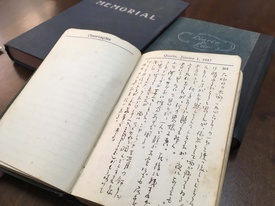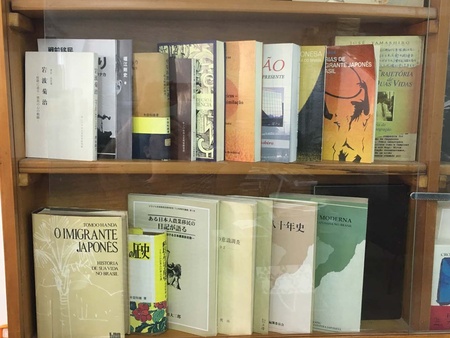In the Liberdade neighborhood, in São Paulo, there is a very rich collection involving people of Japanese descent that is available to the public, from books with academic research to a box full of waribashi (restaurant chopsticks ). This collection belongs to an institution that was created by some Japanese intellectuals shortly after the end of the Second World War.
Since the beginning, it has had publishing activities and operates 100% in Japanese. The Center for Japanese-Brazilian Studies (CENB)—or Jinmonken , in Japanese—has a very important role when it comes to Japanese immigration to Brazil.
Collection

There are two collections to keep books in Japanese and works in other languages separately. In Japanese, there are around 4 to 5 thousand books, in addition to magazines, and in Portuguese and other languages there are around a thousand books—there are magazines too. The books, mainly in other languages, deal not only with Japanese immigration, but with the immigration of other groups such as Italians, Poles and Germans. In general, these volumes are purchased, but they also receive donations. What is not incorporated into the collection is donated to community entities or, in the case of books in Japanese, to universities in Japan linked to Brazil.
The entire bibliographic collection is computerized and can be consulted online, on the Jinmonken website. The catalog for books in Japanese is in the Japanese part of the website and the catalog for other languages is in the Portuguese part. The various documents (photo albums, maps, audio tapes, video tapes, personal documents, objects), which are archival material, are not yet catalogued. However, there is a project to provide this service in the archival area.
Access is free to researchers, there is no fee to consult the collection and it is also not necessary to schedule a visit.
Among visitors to the CENB collection, Nikkei and Japanese speakers make up the vast majority. The general public is researchers, intellectuals, but there are also journalists, painters and even people from other countries such as Germany, South Korea and the United States.
Activities
Around the 1990s, the Center for Japanese-Brazilian Studies published the magazine Kenkyu Repooto – which brought together the results of research by members of the institution and went through a remodeling process, becoming “Jinmonken Magazine”, leaner, with works academics, dissertations.
In addition to the magazine, it occasionally publishes books authored by members of the entity—at the beginning of its history, it even published topics related to Brazil in Japanese.

To publish books, the Center uses funding from foundations that are interested in the activities of the Japanese-Brazilian community, such as, for example, the Katsuzo Yamamoto Foundation and the Kunito Miyasaka Foundation.
For internal functioning, they rely on financial investments and investments, and also the system of members, both individuals and legal entities, who pay an annual fee.
Research seminars have also been promoted since the 1970s, most of them linked to immigration, but sometimes with forays into other topics. With the aim of disseminating academic knowledge, being open to the general public, these meetings offer the possibility for participants to interact with the speaker in the question and answer session at the end of the event. The seminars are recorded and available for consultation.
Such meetings are held in the space of the Historical Museum of Japanese Immigration in Brazil and the Federation of Associations of Japanese Provinces in Brazil—KENREN, located in the same building where Jinmonken's headquarters are located.
Without pretensions to academic study, the Center for Japanese-Brazilian Studies also promotes a series created by Yosuke Tanaka, which are old stories of the Nikkei community that some people tell, a kind of particular episodes in the history of immigration.
And, only for the “usual public”, research communications are carried out. These are generally works by younger researchers, sometimes doctoral candidates.
Still in the research field, CENB usually participates in more specific collaborative projects together with JICA (Japan International Cooperation Agency). Such projects result in reports that are also published.
Japanese scholarships and volunteers
The researcher training program began as a scholarship for an undergraduate student and ran for four editions. Later, this program underwent a reformulation to serve postgraduate students, offering a more generous scholarship, and was maintained from 2009 to 2015. The objective was to train researchers to remain at the entity.
Those who maintained the program were donors, individuals and legal entities - some are individuals, others are entities - with the aim of promoting research. Contracts are usually for one year, sometimes with the possibility of extension for another year.
More recently, the institution had two experiences with JICA volunteers from Japan. The first was to organize the collection, in 2008, carried out by a librarian who implemented the labels, the digital catalogue, etc.
Today it has two volunteers. One is dedicated to institutional history and the other is helping with the collection, setting up magazine indexes and digitizing them to facilitate searching. In the near future, Jinmonken has a project to recruit more volunteers for JICA to continue the work of the current ones or to definitively become the entity's archivist and collect and catalog archival documentation.
Historic
The Center for Japanese-Brazilian Studies (CENB) emerged from the Doyo-kai group (Sábado Group), formed shortly after the end of the Second World War by Japanese intellectuals living in Brazil. Doyōkai's main objective was to study Brazilian culture and society and, within this context, discuss Japanese immigration.
Later, some members of the Group created the São Paulo Human Sciences Study Circle, predecessor of the current CENB. The activities of this group focused on the research areas of Brazilian history and sociology, in addition to seeking greater understanding of populations of Japanese origin in the country.
The Study Circle operated for 15 years until the creation of the Center for Japanese-Brazilian Studies, in March 1965.
CENB was responsible for the training of several researchers, such as the now deceased Hiroshi Saitō (sociologist, former professor at the University of São Paulo) and Teiichi Suzuki (former professor at the University of São Paulo, first president of the Casa de Cultura Japonesa-USP ), as well as Takashi Maeyama (anthropologist, former professor at the University of Shizuoka, Japan), all outstanding in their respective fields of study.
Thus, there was a change in the entity's focus—from “Brazilian studies” to “studies on Japanese immigration and related topics”.
© 2017 Tatiana Maebuchi






